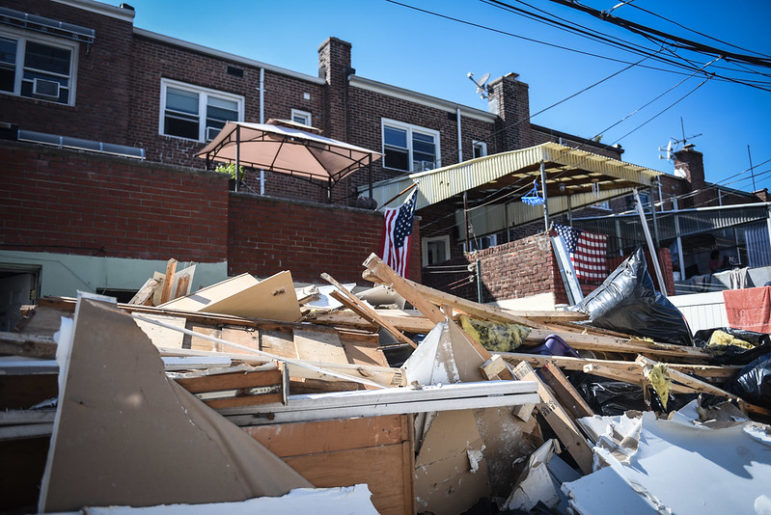As of last month, the state had doled out just over $2 million of the $27 million set aside for the relief fund, according to recent data shared with City Limits. In total, 405 of the 554 New Yorkers who applied have been approved, and 352 have actually received the aid.

Michael Appleton/Mayoral Photography Office
Ida aftermath in Queens.The last remnants of Hurricane Ida flooded the streets of New York City more than a year ago, killing more than a dozen New Yorkers and damaging thousands of homes and other property.
More than 20 days after the September 2021 storm, the city and state announced a $27 million Ida relief fund to help undocumented victims who didn’t qualify for aid administered by the Federal Emergency Management Agency (FEMA) because of their immigration status.
The program was immediately hailed as historic, the first time that New York created a relief program for undocumented families who had been excluded from other assistance. Six community-based organizations (CBO) were in charge of both the application process and the distribution of the funds, all under the supervision of the New York State Office for New Americans (ONA).
More than a year after the storm hit and after the state extended the application period several times, the program closed at the end of April. As of last month, it had still only disbursed a little more than $2 million of the allocated $27 million, with about 200 applicants still waiting on funds, according to recent data shared with City Limits.
In total, 405 of the 554 New Yorkers who applied for the relief program have been approved, which means they filed and documented their losses properly. Of those, 352 applicants have received funds already, according to New York’s Department of State. The majority of the aid has been given to applicants in Queens, which was heavily hit by the storm and where the majority of Ida fatalities took place.
| Ida Fund Distribution | |
| County | Amount |
| Bronx | $216,919 |
| Brooklyn | $144,506 |
| Nassau | $92,805 |
| Queens | $1,253,983 |
| Staten Island | $26,860 |
| Rockland | $2,194 |
| Suffolk | $21,866 |
| Westchester | $300,860 |
| Total | $2,059,993 |
There is a long road from initial screening to approval for the program, explained representatives from CBOs in charge of the process: applicants must provide documentation of their storm losses with photos and receipts. In some cases, such as the loss of a vehicle, applicants must first purchase a new car before they can be reimbursed.
The application process “is rather long and cumbersome,” said Becca Talzek, deputy director of Make the Road New York, one of the groups contracted to process applications. “It requires a lot of documents.”
Providing sufficient documentation has been the biggest obstacle for applicants, administrators say. Of the 323 initial applications Make the Road received, Talzek explains, 252 managed to gather all the paperwork to get successfully approved for aid.
Benjamin Eng, Ida relief fund program coordinator at the Chinese-American Planning Council, said his organization has received an estimated 200 calls related to the program. Most of those people did not qualify because they were eligible for federal aid, and they were referred to FEMA instead (in total, more than 600 people who inquired with contracted CBOs about the fund were likewise eligible for and referred to FEMA’s aid program instead, according to the State Department).
CPC worked with the remaining 54 households to apply, and all received funding, Eng said. “For us, the process is fairly smooth. Once we finalize an amount for an applicant, it has to go [through] our fiscal team and wait for approval. After that, the funds will go to the applicant’s bank account or a preloaded debit card,” he added.
With tens of millions of dollars in the fund still unspent, some local lawmakers have urged the city and state to reopen applications yet again for the program. In a letter sent to Mayor Eric Adams and Gov. Kathy Hochul this fall, State Sen. Jessica Ramos and Assemblymember Jessica González-Rojas called for the application period to be extended through October 2023.
“Our communities continue to suffer from damages caused by Hurricane Ida due to the extent of destruction and the difficulties our constituents have faced in applying for and receiving assistance,” the lawmakers wrote, according to Spectrum NY1.
But little progress has been made in the last five months in terms of aid distribution. Since City Limits last checked in on the effort in September, which marked the first anniversary of the storm, only 22 additional people have received relief money, with $158,961 doled out between then and mid-January.
Advocates and representatives of the administering CBOs have said that they would like any unused portions of the earmarked $27 million to go to another kind of relief program for the same population, or to establish a permanent fund for future undocumented storm victims. The state has yet to comment on that possibility.
“Money has been going out the door for the last year,” said Mercedes Padilla, a spokesperson for New York’s Department of State. “If every eligible person currently enrolled in the program receives the full amount of funding, we’ll get through the entire fund.”
That seems unlikely, however. While households can technically receive up to $72,000 in aid through the initiative, the average amount each applicant has received so far was just $5,825.
Most of the funding that has been distributed went to cover what the fund refers to as “other needs,” which includes things like funeral assistance, child care, vehicle damages, moving, and transportation. Another $592,096.98 has been disbursed for housing related aid, like repairs to a residence, payments for temporary lodging in hotels or motels, and rental assistance.








